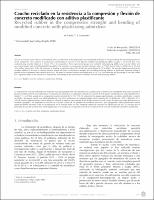Mostrar el registro sencillo del ítem
Recycled rubber in the compressive strenght and bending of modified concrete with plasticizing admixtrue
| dc.contributor.author | Farfan, M | |
| dc.contributor.author | Leonardo, E | |
| dc.date.accessioned | 2019-06-02T22:06:33Z | |
| dc.date.available | 2019-06-02T22:06:33Z | |
| dc.date.issued | 2018 | |
| dc.identifier.issn | 0716-2952 | |
| dc.identifier.uri | https://hdl.handle.net/20.500.12692/33590 | |
| dc.description.abstract | The use of concrete made with recycled materials allows an alternative in the optimization and considerable reduction of resources during the manufacturing process of the components. The resistance to compression and bending in concrete of 210 Kg/cm2 modified with plastifying additive at ages 7, 14 and 28 days were evaluated using recycled rubber of 5, 10 and 15% in its composition. Three experimental groups were included, with plasticizing admixture and recycled rubber, and two control groups, with and without plastifying additive. The resistance to compression reached maximum values of 218.45 Kg/cm2 and 212.33 Kg/cm2 at 5% and 10% rubber, respectively. As for the flexural strength, a maximum value of 81.86 Kg/cm2 was achieved for 10% rubber. The recycled rubber proved to be an excellent addition to be used in concrete mixtures despite the losses of mechanical strength, but by adding plastifying additive, it significantly improves making it possible to be incorporated into concrete up to 10%. By means of variance analysis with significance of 5%, it is concluded that the percentage of recycled rubber has a significant effect on the resistance to compression and bending in the manufacture of modified concrete with plastifying additive. | es_PE |
| dc.description.abstract | La utilización de concreto elaborado con materiales reciclados permite tener una alternativa en la optimización y disminución considerable de recursos durante el proceso de fabricación de los componentes. Se evaluaron las resistencias a compresión y flexión en concreto de 210 Kg/cm2 modificado con aditivo plastificante a edades 7, 14 y 28 días, usando en su composición caucho reciclado de 5, 10 y 15%. Se incluyeron tres grupos experimentales, con aditivo plastificante y caucho reciclado, y dos grupos control, con aditivo plastificante y sin él. La resistencia a la compresión logró valores máximos de 218.45 Kg/cm2 y 212.33 Kg/cm2 a 5% y 10% de caucho, respectivamente. Para la resistencia a flexión se logró un valor máximo de 81.86 Kg/cm2 para 10% de caucho. El caucho reciclado demostró ser un excelente agregado a ser empleado en mezclas de concreto a pesar de las pérdidas de resistencia mecánica, pero agregándole aditivo plastificante mejora significativamente haciendo viable su incorporación en el concreto hasta en 10%. Mediante análisis de varianza con significancia de 5%, se concluye que el porcentaje de caucho reciclado tiene efecto significativo en la resistencia a compresión y flexión en la fabricación de concreto modificado con aditivo plastificante | es_PE |
| dc.format | application/pdf | es_PE |
| dc.language.iso | spa | es_PE |
| dc.publisher | Escuela de Ingeniería. Pontificia Universidad Católica de Chile | es_PE |
| dc.relation.uri | https://scielo.conicyt.cl/pdf/ric/v33n3/0718-5073-ric-33-03-241.pdf | es_PE |
| dc.rights | info:eu-repo/semantics/openAccess | es_PE |
| dc.rights.uri | https://creativecommons.org/licenses/by-nc-sa/4.0/ | es_PE |
| dc.source | Universidad César Vallejo | es_PE |
| dc.subject | Rubber | es_PE |
| dc.subject | Concrete | es_PE |
| dc.subject | Strength | es_PE |
| dc.subject | Compression | es_PE |
| dc.subject | Bending | es_PE |
| dc.subject | Caucho | es_PE |
| dc.subject | Concreto | es_PE |
| dc.subject | Resistencia | es_PE |
| dc.subject | Compresión | es_PE |
| dc.subject | Flexión | es_PE |
| dc.title | Recycled rubber in the compressive strenght and bending of modified concrete with plasticizing admixtrue | es_PE |
| dc.title.alternative | Caucho reciclado en la resistencia a la compresión y flexión de concreto modificado con aditivo plastificante | es_PE |
| dc.type | info:eu-repo/semantics/article | es_PE |
| thesis.degree.grantor | Universidad César Vallejo. Escuela de Posgrado | es_PE |
| dc.description.sede | Ate | es_PE |
| dc.description.peerreview | Revisión por pares | es_PE |
| dc.contributor.email | mfarfan@ucv.edu.pe | es_PE |
| dc.identifier.doi | https://doi.org/10.4067/S0718-50732018000300241 | |
| dc.source.journaltitle | Revista Ingeniería de Construcción | es_PE |
| dc.source.volume | 33 | es_PE |
| dc.source.beginpage | 241-250 | es_PE |
| dc.identifier.isni | 0000 0001 2229 9873 | |
| dc.subject.ocde | https://purl.org/pe-repo/ocde/ford#5.00.00 | es_PE |
| dc.relation.isPartOf | urn:issn:0716-2952 | es_PE |



